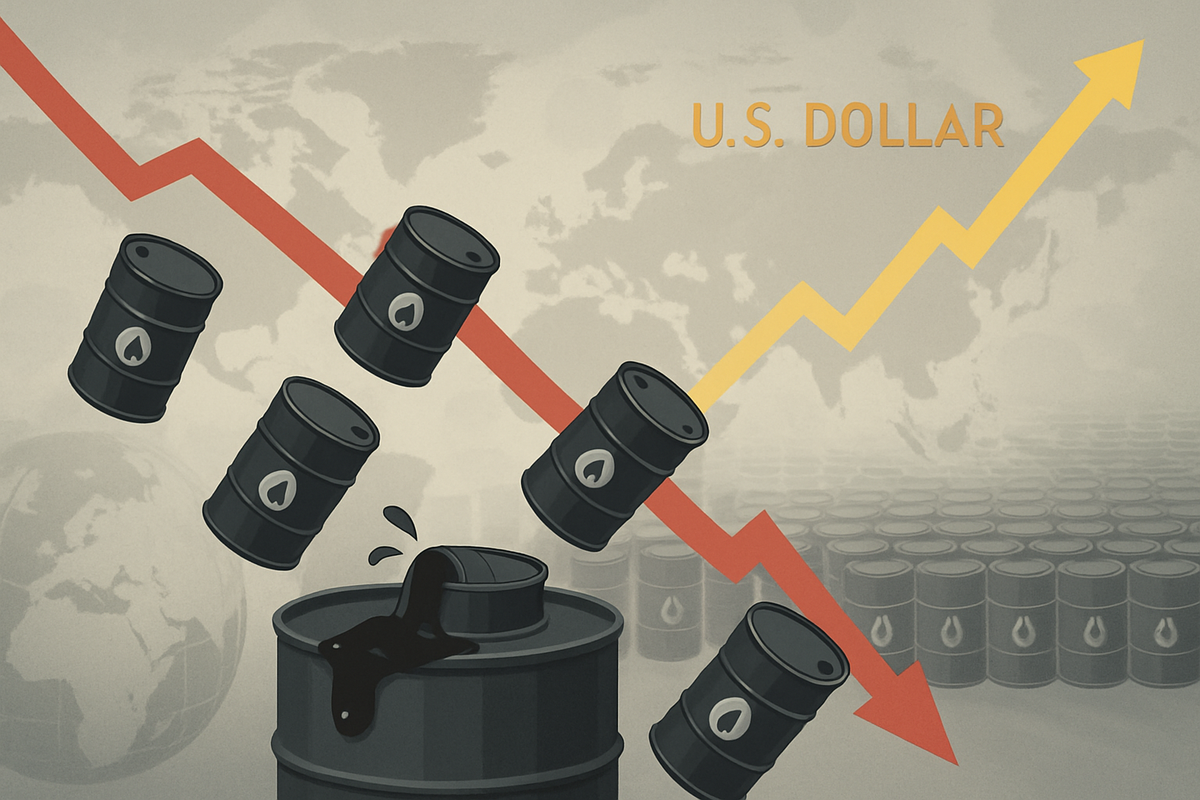Financial News
Oil Markets Reel as Strengthening Dollar and Oversupply Fears Drive Prices Down

New York, NY – October 14, 2025 – The global crude oil market is currently in the throes of a significant downturn, with benchmark prices plummeting to multi-month lows. This sharp dip is largely attributed to a potent combination of a strengthening U.S. dollar and a burgeoning outlook for substantial oversupply in the fourth quarter of 2025 and into 2026. The confluence of these factors has reshaped market sentiment, pushing crude prices lower and fostering a "risk-off" mood among investors, signaling a dramatic shift from earlier expectations of a tighter market.
As of October 14, 2025, Brent crude futures are trading just below $62 a barrel, settling at $61.60, marking a 7.83% decline over the past month and a staggering 16.29% drop year-over-year. Similarly, West Texas Intermediate (WTI) crude futures have fallen to approximately $58.3 per barrel, settling at $58.70, hitting a five-month low. This sustained decline is making dollar-denominated oil more expensive for international buyers, consequently reducing demand and intensifying the downward pressure on prices, creating a challenging environment for producers and a potential boon for consumers.
Unpacking the Market's Recent Tremors
The recent dip in crude oil prices on October 14, 2025, is the culmination of a series of interconnected events and shifting global dynamics. While crude began 2025 around $74 per barrel, peaking at $81 on January 15, it has been in a steady decline since, with Brent crude falling to $66 per barrel by the end of June. The most significant pressures emerged in early October, marked by a critical ceasefire agreement between Israel and Hamas on October 3, which notably eased geopolitical war risk premiums that had previously supported prices. This was followed by a modest production adjustment by OPEC+ nations on October 5, increasing output by 137,000 barrels per day (b/d) for November, a move that, while tempered, contributed to the supply side.
Crucially, the U.S. Energy Information Administration (EIA) released its Short-Term Energy Outlook (STEO) on October 7, forecasting significant growth in global oil inventories and predicting Brent crude prices would fall to an average of $62/b in Q4 2025 and $52/b in 1H 2026. This bearish outlook was reinforced on October 14 by a similar report from the International Energy Agency (IEA), which raised its global oil supply growth forecast while lowering demand projections. Simultaneously, escalating U.S.-China trade tensions, including new sanctions and threatened tariffs, further amplified concerns about a potential global economic slowdown, directly impacting the demand outlook for oil.
Key players in this unfolding scenario include the OPEC+ alliance, whose production decisions directly influence global supply; the United States, through its trade policies with China and the monetary policies of the Federal Reserve, which dictate the strength of the dollar; and China, whose economic health and trade relations significantly impact global oil demand. Energy agencies like the IEA and EIA play a crucial role by providing forecasts that shape market sentiment. Geopolitical actors, including those in the Middle East and the Russia-Ukraine conflict, also contribute to market volatility.
Initial market reactions on October 14 were distinctly bearish. Both Brent and WTI benchmarks plummeted, with Brent struggling to maintain $62/bbl and WTI dipping below $59/bbl. The futures market rapidly shifted into "contango," where longer-dated contracts trade at a premium to near-term contracts, signaling widespread expectations of a prolonged supply surplus. Energy trading floors were reportedly gripped by pessimism, with analysts and executives from major oil trading houses warning that prices could slide further into the $50s range, signaling significant pressure on the profitability of energy companies, particularly those in higher-cost regions like U.S. shale.
Winners and Losers in a Shifting Landscape
The recent plunge in crude oil prices is creating a clear delineation between winners and losers across the financial markets. Companies directly involved in oil extraction and services are bracing for impact, while those reliant on fuel as a major operating expense are poised for a significant boost.
Companies Likely to Lose:
The most immediate casualties of falling crude prices are Upstream Oil and Gas Producers (E&P companies). These firms, whose revenues are directly tied to the price of oil, will see their profitability eroded. Lower prices mean reduced revenue per barrel, squeezing operating margins and potentially leading to financial losses, particularly for smaller, independent producers operating above the current break-even points. This often translates to negative stock performance as investors recalibrate earnings forecasts. Companies like ExxonMobil (NYSE: XOM) and Chevron (NYSE: CVX), despite their integrated operations, will feel substantial pressure on their upstream divisions. For instance, a $1 change in oil prices can alter Chevron's earnings per share by $0.33. Independent E&P firms such as Diamondback Energy (NASDAQ: FANG) have already begun trimming capital budgets, with Diamondback cutting its 2025 budget by $400 million and planning fewer wells. Similarly, Coterra Energy (NYSE: CTRA) announced a 30% cut in its Permian rig count, signaling a broader industry contraction in drilling activity.
Oilfield Services Companies also face significant headwinds. These firms, including giants like SLB (NYSE: SLB) (formerly Schlumberger), Halliburton (NYSE: HAL), and Baker Hughes (NASDAQ: BKR), provide the crucial equipment, technology, and services for drilling and completing wells. A decline in E&P spending directly translates to reduced demand for their services, leading to lower revenues, decreased equipment utilization, and intense pricing pressure. SLB has already warned of lower spending by producers and is focusing on cost cuts, while Halliburton and Baker Hughes have flagged cautious customer spending, particularly in North America. Their stock performance is typically negative in such environments, prompting operational strategies focused on cost reduction and workforce adjustments.
Companies Likely to Win:
Conversely, sectors with high fuel consumption stand to gain significantly. Airlines are among the biggest beneficiaries, as jet fuel constitutes a substantial portion—typically around 30%—of their operating costs. Lower crude prices translate directly into reduced fuel expenses, boosting profit margins and freeing up capital for investments or shareholder returns. Major carriers like Delta Air Lines (NYSE: DAL) and Southwest Airlines Co. (NYSE: LUV) could see their annual fuel bills shrink considerably, leading to improved financial performance and potentially positive stock reactions.
Transportation and Logistics Companies, including shipping, trucking, and rail operators, also stand to benefit. Firms such as FedEx Corp (NYSE: FDX) and United Parcel Service (NYSE: UPS), which incur massive fuel costs to move goods globally, will see their operational expenses decrease. This can lead to higher margins, more competitive pricing, and potentially increased freight volumes.
Refining and Downstream Oil Operations are another sector poised for gains. Refiners purchase crude oil as their primary input and sell refined products like gasoline and diesel. When crude prices fall, and demand for refined products remains stable or strong, refining margins—known as "crack spreads"—tend to widen, enhancing profitability. Companies like Valero Energy (NYSE: VLO), Marathon Petroleum (NYSE: MPC), and Phillips 66 (NYSE: PSX) are well-positioned to capitalize on cheaper crude inputs, leading to improved financial results.
Finally, Chemical Companies and other Energy-Intensive Industries will also see benefits. The chemical industry uses crude oil derivatives as key feedstocks for products ranging from plastics to synthetic rubber. Lower crude prices directly reduce raw material costs, improving operating margins for companies like Dow Inc. (NYSE: DOW) and LyondellBasell Industries (NYSE: LYB). More broadly, lower oil prices alleviate inflationary pressures, provide relief to household budgets, and can stimulate overall economic activity by increasing disposable income, indirectly benefiting various sectors from manufacturing to agriculture.
Broader Implications and Historical Context
The crude oil price dip on October 14, 2025, is more than a fleeting market correction; it signifies a pivotal shift in global energy dynamics, echoing historical precedents while underscoring new realities. This downturn fits squarely into broader industry trends characterized by robust non-OPEC+ supply growth, moderating global demand, and the accelerating energy transition.
The market is witnessing a significant return to oversupply, primarily fueled by resilient production from non-OPEC+ nations, particularly the U.S. shale industry, which has consistently exceeded output expectations, reaching over 13.6 million barrels per day (bpd) in July 2025. This surge in supply is meeting a moderating global demand, forecast at around 700,000 bpd in 2025 and 2026, well below historical averages. Factors contributing to this subdued demand include a harsher macroeconomic climate, increased vehicle efficiencies, strong electric vehicle (EV) sales, and slowing economic growth in major consuming nations like China. Concurrently, OPEC+ has been gradually unwinding its voluntary production cuts, adding further barrels to an already saturated market.
These dynamics create significant ripple effects. Upstream producers will face intense fiscal pressure, potentially leading to curtailed investments and increased focus on capital discipline and operational efficiency. Integrated majors like BP (LSE: BP), Shell (LSE: SHEL), and TotalEnergies (EPA: TTE) will see their upstream divisions challenged, likely accelerating their diversification into renewable energy. OPEC+ nations, particularly those with limited financial reserves, could face economic instability, compelling them to pursue aggressive economic diversification strategies and potentially straining internal cohesion if deeper production cuts become necessary to stabilize prices. Conversely, downstream refiners will likely thrive on wider crack spreads, while energy-intensive industries and consumers will benefit from reduced costs, providing a de facto economic stimulus. The renewable energy sector, while facing potential short-term scrutiny due to cheaper fossil fuels, could paradoxically see accelerated long-term investment as the inherent volatility and geopolitical risks of fossil fuels are once again highlighted.
From a regulatory and policy perspective, governments may strategically replenish their Strategic Petroleum Reserves (SPRs) during this period of lower prices, enhancing energy security. The market volatility could also strengthen the resolve of governments to push decarbonization policies, promoting renewable energy adoption and electric vehicle incentives. Oil-dependent nations will be further incentivized to aggressively pursue economic diversification. Central banks might find some relief from inflationary pressures, but the strong U.S. dollar, a key driver of the dip, could lead to "imported inflation" in other economies, necessitating careful monetary and fiscal responses.
Historically, this crude oil price dip shares striking similarities with the 2014-2016 oil glut, which was also characterized by a significant oversupply from surging U.S. shale production and weakening global demand. During that period, Brent crude fell from over $100 to around $50 per barrel. While not as severe as the 2020 COVID-19 collapse, which saw WTI futures briefly turn negative due to unprecedented demand destruction, the element of moderating demand plays a crucial role. Comparisons can also be drawn to the 1980s oil glut, where increased non-OPEC production and reduced demand led to a sharp price drop. These historical precedents underscore the challenge OPEC+ faces in managing market share versus price stability in an oversupplied market. The current dip, as of October 14, 2025, is predominantly a supply-driven oversupply scenario, compounded by moderating demand, prompting significant re-evaluation and strategic adaptations across the energy sector.
The Road Ahead: Navigating Future Volatility
The road ahead for crude oil markets, following the significant price dip on October 14, 2025, is fraught with both challenges and opportunities, demanding strategic pivots from all market participants. The immediate future, extending through Q4 2025 and into 2026, appears predominantly bearish, with the U.S. Energy Information Administration (EIA) forecasting Brent crude to average around $62 per barrel in Q4 2025, potentially dropping to $52 per barrel in 2026, and WTI following suit.
Short-term possibilities point to continued price declines driven by a persistent global oversupply. Global oil inventories are projected to build substantially, averaging 2.6 million bpd in Q4 2025, fueled by robust non-OPEC+ production—particularly from the U.S., Brazil, Canada, Guyana, and Argentina—and the gradual unwinding of OPEC+ cuts. This oversupply meets a weakening demand growth, with global oil use expected to remain subdued at around 700,000 bpd annual gains, a stark contrast to historical trends, influenced by a harsher macroeconomic climate, increasing vehicle efficiencies, and strong electric vehicle (EV) sales. The strengthening U.S. dollar will continue to make dollar-denominated oil more expensive for international buyers, further dampening demand. This will likely solidify the market's shift into "contango," where prompt contracts trade below later ones, signaling expectations of a prolonged surplus.
Looking at long-term possibilities beyond 2026, oil prices are likely to remain in a lower range or continue a gradual decline. Global fossil fuel demand is widely expected to peak by 2030, driven by accelerating energy transition policies and widespread EV adoption. This sustained downward pressure could see equilibrium oil prices revised to a $50-$60 per barrel range beyond 2030. While a prolonged period of low oil prices could diminish the economic incentive for new conventional oil and gas investments, paradoxically, cheaper oil might also reduce the immediate economic case for consumers to switch to EVs or for utilities to favor renewable alternatives, potentially slowing the energy transition in the short term.
Strategic pivots and adaptations are critical. Oil-producing nations must accelerate economic diversification and implement fiscal reforms to reduce their reliance on volatile oil revenues. Energy companies, especially U.S. shale producers facing 2026 futures below break-even levels, must prioritize capital discipline, cost management, and shareholder returns over growth. Diversification into broader energy portfolios, including increased investment in renewables and energy transition technologies, will be essential for long-term resilience. Oil-importing nations have an opportunity for strategic stockpiling to build reserves during periods of lower prices, enhancing energy security.
Market opportunities include cost relief for energy-intensive industries like aviation and shipping, which can boost their profitability. Strategic stockpiling by importing nations also presents an opportunity. Furthermore, while low oil prices might seem to challenge renewables, the inherent volatility of fossil fuels could accelerate long-term investment in stable, domestically sourced energy solutions. Challenges, however, abound: continued price volatility, fiscal pressure on oil-producing nations, reduced upstream investment potentially leading to future supply shortfalls, macroeconomic headwinds, and persistent regulatory and environmental pressures.
Potential scenarios and outcomes range from an oversupply-driven bear market in the short-to-medium term, leading to continued inventory builds, to an accelerated energy transition in the long term, with global oil demand peaking by 2030. There's also the paradoxical outcome of a slower energy transition in the short term if cheaper oil reduces immediate incentives for switching. Geopolitical disruptions always pose a risk for temporary price spikes, but are unlikely to fundamentally reverse the trend of oversupply. Ultimately, the market could rebalance if low prices lead to reduced investment and subsequent production declines, creating tighter conditions beyond the immediate bearish outlook.
Conclusion: A Market in Flux
The current dip in crude oil prices, as of October 14, 2025, is a multifaceted event with profound implications for global financial markets and the broader economy. It serves as a stark reminder of the intricate dance between supply, demand, monetary policy, and geopolitics that dictates the energy landscape.
Key Takeaways from the Event:
The primary drivers of this downturn are clear: a burgeoning oversupply stemming from robust non-OPEC+ production—especially from the U.S.—meeting moderating global demand influenced by a challenging macroeconomic climate and the accelerating energy transition. Exacerbating this is a strengthening U.S. dollar, which makes dollar-denominated oil more expensive for international buyers, further dampening demand. While OPEC+ dynamics have historically aimed to stabilize prices, reports of some members willing to tolerate lower prices and even push for output hikes have contributed to the oversupply. Though not the immediate cause, underlying geopolitical currents continue to add layers of complexity, with de-escalation of tensions capable of triggering price drops, much like a potential Gaza ceasefire did recently.
Assessment of the Market Moving Forward:
The consensus points to continued bearish sentiment in the short to medium term. The EIA forecasts Brent crude to average around $62 per barrel in Q4 2025, potentially dropping to $52 per barrel in 2026, with WTI following suit. This outlook is predicated on sustained non-OPEC+ production, the gradual unwinding of OPEC+ cuts, and subdued global demand. However, counterbalancing factors exist. Prolonged underinvestment in new production capacity could create future supply constraints, and oil consumption might prove more resilient than expected in developing economies. OPEC+ also retains the flexibility to adjust production targets. The $60 per barrel threshold is particularly critical for U.S. shale economics; sustained prices below this level could lead to a decline in U.S. oil production in 2026, eventually rebalancing the market.
Final Thoughts on Significance and Lasting Impact:
This price dip is not merely a temporary blip but reflects deeper, evolving dynamics. For economic growth, lower fuel costs can stimulate demand and benefit energy-intensive industries, offering a de facto tax cut for consumers. However, a prolonged decline could also signal broader global economic weakness if driven by persistent demand concerns. Oil producers, especially those heavily reliant on oil revenues, face increased fiscal pressure, accelerating their need for economic diversification. The volatility underscores the oil industry's inherent vulnerability to "black swan" events and the intricate interplay of economic, geopolitical, and supply-side factors. Ultimately, the energy transition introduces a long-term structural shift in demand that coexists with cyclical economic fluctuations, creating complex and often unpredictable future supply/demand dynamics.
What Investors Should Watch For in Coming Months:
Investors must remain vigilant. Key indicators to monitor include OPEC+ production decisions and compliance rates, which will significantly impact global supply. Global economic data, particularly from the.S. and China, will dictate demand outlooks. The trajectory of U.S.-China trade relations will profoundly influence global economic growth and energy demand. The strength of the U.S. dollar will continue to affect the affordability of oil for international buyers. Regular inventory reports from the API and EIA will provide crucial insights into supply and demand balances. Finally, while less impactful than supply-demand fundamentals in the current dip, new geopolitical developments in oil-producing regions could quickly reintroduce supply risks and price premiums. The response of U.S. shale producers to lower prices, particularly around the $60/bbl break-even point, will be critical for future supply.
This content is intended for informational purposes only and is not financial advice
More News
View More




Recent Quotes
View More
Quotes delayed at least 20 minutes.
By accessing this page, you agree to the Privacy Policy and Terms Of Service.



